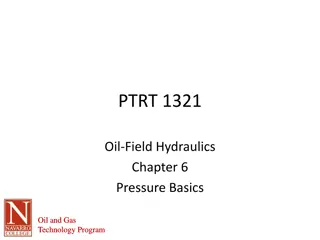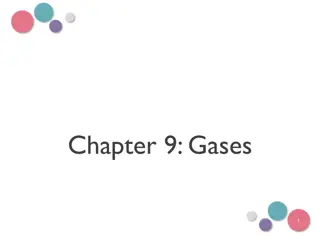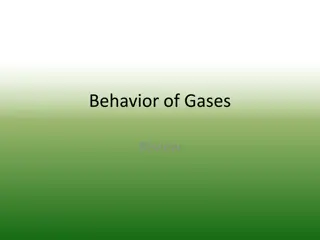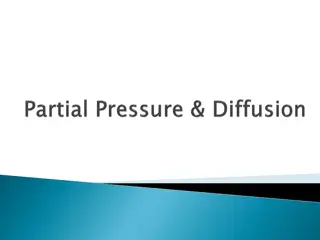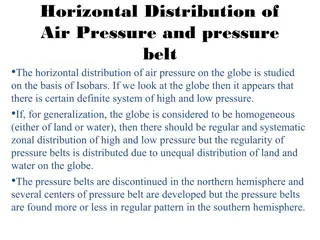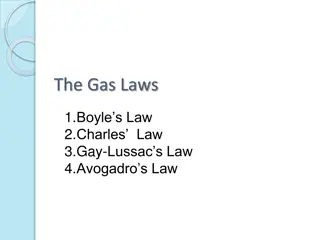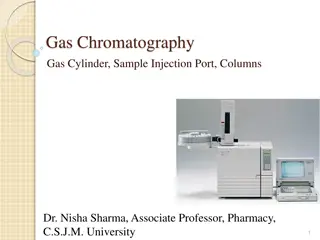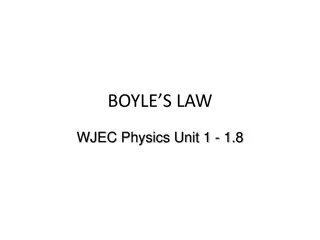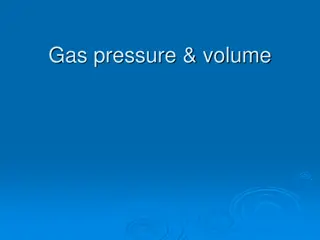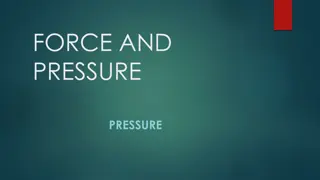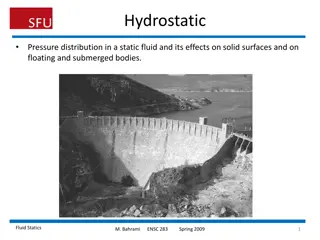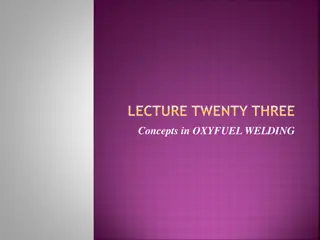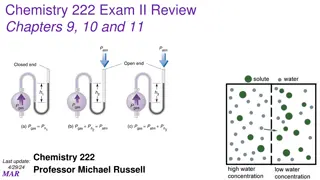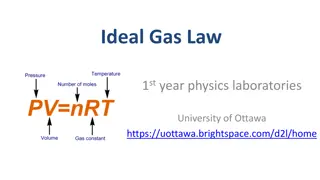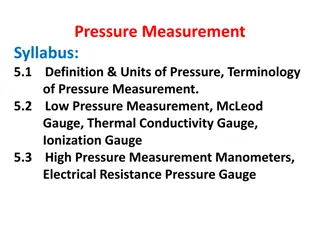Gas Laws and Pressure Units
Explanation and application of gas laws, pressure units, and temperature-volume relationships through examples and images. Topics covered include Boyle's law, volume-temperature relationships, and identifying pressure units. Learn how to calculate and interpret pressure and volume changes in gas systems.
Download Presentation

Please find below an Image/Link to download the presentation.
The content on the website is provided AS IS for your information and personal use only. It may not be sold, licensed, or shared on other websites without obtaining consent from the author.If you encounter any issues during the download, it is possible that the publisher has removed the file from their server.
You are allowed to download the files provided on this website for personal or commercial use, subject to the condition that they are used lawfully. All files are the property of their respective owners.
The content on the website is provided AS IS for your information and personal use only. It may not be sold, licensed, or shared on other websites without obtaining consent from the author.
E N D
Presentation Transcript
1 9 10 11 12 13 14 15 16 17 18 19 20 21 22 23 24 25 26 27 28 29 30 31 32 33 34 35 36 37 38 39 40 2 3 4 5 6 7 8
Answer: B 80 mm Hg RETURN The mixture is 10% oxygen; 800 mm Hg x 0.10 = 80 mm Hg
Volume and Temperature are proportional. As one goes up, so does the other. RETURN
Which of the following is not a unit of pressure? A Newton B mm Hg C atmosphere D Pascal
Which of the following is not a unit of pressure? A Newton RETURN
The volume of a balloon is 20 L when the temperature is 20 degree celsius. If the temperature is raised to 50 degrees celsius, what is the new volume? A) 18.1 L B) 20 L C) 22.0 L D) 50 L
The volume of a balloon is 20 L when the temperature is 20 degree celsius. If the temperature is raised to 50 degrees celsius, what is the new volume? Answer: C) 22.0 L Remember, the temperature must be converted to Kelvin first (20 + 273) = 293 K, (50 + 273) = 323 K (20 L/293 K) = ( ?? L/323 K) ?? = 22.0 L RETURN
Free Point RETURN
According to Boyles law, the relationship between the pressure and volume of a gas at constant temperature is a. numerically equivalent b. inversely proportional c. positively correlated d. totally unrelated
According to Boyles law, the relationship between the pressure and volume of a gas at constant temperature is Answer: b. inversely proportional RETURN
A balloon is filled with 3.8 L of helium gas at 22.4 atm pressure. If the pressure is lowered to 1.0 atm, what is the new volume? a. 0.17 L b. 0.26 L c. 72 L d. 85 L
A balloon is filled with 3.8 L of helium gas at 22.4 atm pressure. If the pressure is lowered to 1.0 atm, what is the new volume? Answer: d. 85 L When we eliminate temperature from the combined gas law, we get P1V1 = P2V2 (22.4 atm)(3.8 L) = (1.0 atm)P2 P2 = 85 L RETURN
What is standard temperature and pressure? A o K and 1 KPa B 0 C and 1 kPa C o K and 1 atm D 0 C and 1 atm
What is standard temperature and pressure? Answer: D 0 C and 1 atm RETURN
Whose law states that temperature and volume are proportional to one another? A Avogadro B Charles C Boyle D Dalton
Whose law states that temperature and volume are proportional to one another? Answer: B Charles RETURN
Answer: G 0.40 atm If 80% of the mixture is nitrogen, then 20% is oxygen. 0.20 x 2.0 atm = 0.40 atm RETURN
Answer: H 75.00 mL When temperature is excluded from the Combined Gas Law, you end up with P1V1 = P2V2. (100 mL)(600 mm Hg) = (800 mm Hg)(V2) V2 = 75.00 mL RETURN
A gas cylinder is filled with 2.00 moles of oxygen gas at 300.0 K. The piston is compressed to yield a pressure of 400.0 kPa. What is the volume inside the cylinder? a. 6.25 dm3 b. 12.47 dm3 c. 24.9 dm3 d. 31.5 dm3
A gas cylinder is filled with 2.00 moles of oxygen gas at 300.0 K. The piston is compressed to yield a pressure of 400.0 kPa. What is the volume inside the cylinder? Answer: b. 12.47 dm3 Use the ideal gas law, PV = nRT (400 kPa)V = (2.0 moles)(8.31)(300 K) V = 12.47 dm3 RETURN
The SI unit of pressure is: a. liters b. atmospheres c. newtons d. pascals
The SI unit of pressure is: Answer: d. pascals RETURN
Which of the properties below is not characteristic of gases? a. the ability to flow easily b. very high density c. compressibility d. takes the shape of its container
Which of the properties below is not characteristic of gases? Answer: b. very high density Gases have a low density RETURN
A can contains a gas with a volume of 100 L at 0 C. What is the volume of the can if it is heated to 50 C? a. 200 L b. 150 L c. 118 L d. 93 L
A can contains a gas with a volume of 100 L at 0 C. What is the volume of the can if it is heated to 50 C? Answer: c. 118 L When pressure is left out of the combined gas law, V1/T1 = V2/T2 The temperatures must beconverted to Kelvin first, so T1=273 K and T2 = 323 K (100 L/273 K) = (V2/323 K) V2 = 118 L RETURN
A sample of nitrogen occupies 10.0 liters at 25 C and 98.7 kPa. What would be the volume at 20 C and 102.7 kPa? A 7.87 L B 9.45 L C 10.2 L D 10.6 L
A sample of nitrogen occupies 10.0 liters at 25 C and 98.7 kPa. What would be the volume at 20 C and 102.7 kPa? Answer: B 9.45 L Use thecombinedgas law, plugintothe formula, and makesure thetemperaturesare in Kelvin! RETURN
A gas cylinder with a volume of 3.00 dm3 contains 8.00 moles of oxygen gas at a temperature of 50.0 K. What is the pressure inside the cylinder? A 504 kPa B 1110 kPa C 2220 kP D 3320 kPa
A gas cylinder with a volume of 3.00 dm3 contains 8.00 moles of oxygen gas at a temperature of 50.0 K. What is the pressure inside the cylinder? Answer: B 1110 kPa Use theideal gas law, PV = nRT (3.00)P = (8.00)(8.31)(50.0) P = 1110 kPa RETURN
A balloon contains 8.0 liters of gas at 100 K. What is the balloon s volume at 200K? A 4.0 L B 8.0 L C 16.0 L D 24.0 L
A balloon contains 8.0 liters of gas at 100 K. What is the balloon s volume at 200K? Answer: C 16.0 L Using the combined gas law without temperature, V1/T1 = V2/T2 8.0/100 = V2/200 V2 = 16.0 L RETURN
When pressure, volume, and temperature are known, the ideal gas law can be used to calculate: a. the chemical formula b. the ideal gas constant c. compressibility d. the number of moles
When pressure, volume, and temperature are known, the ideal gas law can be used to calculate: Answer: d. the number of moles Ideal gas law includes temperature, pressure, volume and moles, PV = nRT RETURN
How many moles of Hydrogen gas are in a 20 L tank pressurized to 1000 kPa at 300K? A 4.0 moles B 8.0 moles C 16.0 moles D 32.0 moles
How many moles of Hydrogen gas are in a 20 L tank pressurized to 1000 kPa at 300K? Answer: B 8.0 moles P=1000., V=20. L, n=? T=300K (1000)(20) = n(8.31)(300) so n = 8.0 moles Hydrogen RETURN
What is the volume of 1 mole of gas at STP? A 1.0 L B 22.4 L C 100 L D 6.022 x 1023 L
What is the volume of 1 mole of gas at STP? Answer: B 22.4 L RETURN
A 15 liter tank contains 2.0 moles of nitrogen gas at 27 C. What is the pressure of nitrogen inside the tank? (R = 8.314) A 29.9 kPa B 101.3 kPa C 332.4 kPa D 664.8 kPa
A 15 liter tank contains 2.0 moles of nitrogen gas at 27 C. What is the pressure of nitrogen inside the tank? Answer: C 332.4 kPa P=?, V=15 L, n=2.0, T=300K (remember to convert) P(15)=2.0(8.31)(300) so P = 332.4 kPa RETURN
Answer: G a gas-filled balloon expands when it is heated None of the other choices mention a change in temperature ( heated ) or volume ( expands ) RETURN
According to the kinetic-molecular theory, gas particles: a. are in constant motion b. have different shapes c. have different colors d. are in contact with each other
According to the kinetic-molecular theory, gas particles: Answer: a. are in constant motion RETURN



